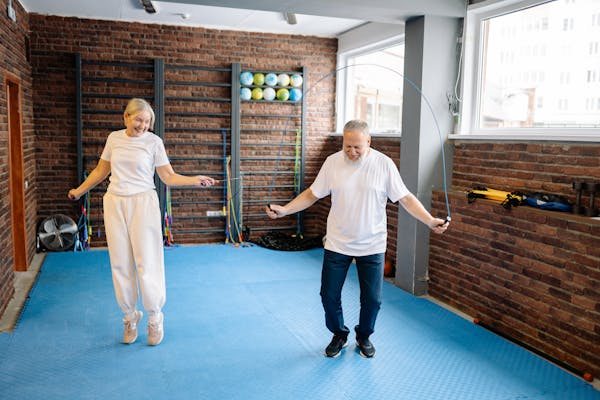Jumping Rope or Skipping has been part of most people’s childhood days. It is used for recreational purposes to pass people’s time or gather in an area. Apart from the fun that it brings, it is also one of the best ways to stay physically fit, mentally active, and emotionally stable, even in the comfort of our homes or while being alone. In this article, we will define skipping or jumping rope exercises, perceive its techniques and types, ways to jump it, and its benefits for effective calorie burning.
What is Skipping or Jumping Rope?
Skipping, also known as rope jumping, serves not only as a childhood pastime and exercise routine but also as a competitive sport. In this activity, individuals or groups jump over a rope swung in a rhythmic motion. The goal is to skillfully maneuver the rope beneath their feet and over their heads as it turns.
What are the techniques and types of Jumping Rope Exercises?
Various techniques are employed during rope jumping, including the Basic Jump or Easy Jump, Speed Step, Criss-Cross, Side Swing, Front-Back Cross, Double Under, Double Dutch, Toad, Leg Over, Awesome Annie, Elephant, Frog/Donkey Kick, Inverse Toad, Combination Jumps, The James Hirst, Scissors, Bell, Skier, Jumping Jack, and Can-Can.
Rope jumping competitions encompass different types, each with its own set of rules and requirements. Organizers typically specify which techniques participants must perform during competitions. These events emphasize various aspects such as stunts, gymnastic moves, athletic prowess, and the form and aesthetic quality of the jumps.
One of the prevalent techniques showcased in competitions is referred to as “multiples,” commonly known as “Double Dutch,” where participants aim to jump high enough for the rope to swing around multiple times. Speed events entail executing the fastest steps within a specified timeframe. Additionally, there are freestyle events, with the most creative sequences being the manipulation sequence. Double Dutch speed events are also featured, with winners determined by the average score from multiple attempts.
In the United States, where the sport has seen significant advancement, the United States Amateur Jump Rope Federation (USAJRF) hosts various annual national tournaments dedicated to rope skipping. Moreover, the sport is a featured discipline in the yearly AAU Junior Olympic Games.
How to Jump Rope?
Here’s a guide on how to jump rope effectively, especially if you’re getting back into the rhythm:
- Hold one end of the jump rope in each hand, ensuring the rope’s loop rests on the ground behind you.
- Swing the rope over your head and around your body in a smooth motion.
- Time your jump as the rope passes under your feet.
- Land softly on the balls of your feet as the rope completes its rotation beneath you.
- Repeat the process with a consistent rhythm.
While jumping rope backward is an option, most prefer seeing the rope coming over their head to minimize tripping risks. Practice regularly to improve your technique and endurance.
What’s the Best Form of Jumping Rope?
“Starting with the right rope size is key,” advises Sklar. “When standing on the center of the rope, its end should reach armpit height.” For an adjustment tip, Sklar suggests adding knots beneath the handles if the rope is too long.
During the actual jump rope session, maintain slightly bent knees and keep upper arms close to your ribs, explains Sklar. “Most of the motion should originate from the wrists, minimizing elbow and shoulder movement,” he adds, recommending against large arm circles.
Matheny recommends aiming to land on the balls of your feet with slightly bent knees upon landing, as this technique helps to cushion the impact of the landing.

What are the Benefits of Jumping Rope?
Jumping rope offers a myriad of potential benefits, with experts highlighting the major ones you should be aware of:
It’s Fun!
According to Sklar, jumping rope is often linked with childhood, which naturally adds an element of fun and novelty compared to spending time on a treadmill or bike. “Jumping rope presents a challenge for both kids and adults,” he notes. “Once you’ve grasped the fundamentals, there are always fresh challenges and opportunities to explore creativity.”
Exercise often feels like a task for many individuals. Nevertheless, jumping rope introduces a fun and remarkably effective workout that can inject joy back into your fitness regimen. Furthermore, you can tailor your jump rope routine to incorporate novelty and challenge as your proficiency improves.
Indeed, the greater your enjoyment of your workout, the higher the likelihood of maintaining it over the long term.
It’s Easy Cardio!
Jumping rope offers significant cardiovascular benefits in a short amount of time. According to Matheny, even just 30 seconds of jumping rope can initiate a noticeable effect, engaging various muscle groups and enhancing coordination.
Moreover, if your schedule feels packed and finding time for exercise is a challenge, jumping rope can help streamline your workouts. (CDC) or Centers for Disease Control and Prevention recognizes vigorous activities such as jumping rope as twice as efficient as moderate-intensity exercises. Therefore, by making jumping rope your primary exercise, you could cut down your weekly workout time to just 75 minutes, alongside muscle-strengthening routines, compared to the time needed for moderate activities like brisk walking.
Jumping rope is classified as a high-intensity activity, noted by Dr. Sulapas, which prompts a rapid increase in your heart rate. According to Sklar, this exercise engages your entire body, necessitating significant effort from your heart to sustain the movement once you begin.
Jumping rope serves as an excellent method to enhance your cardiorespiratory fitness, as supported by various trusted sources. Sustained jumping necessitates increased blood and oxygen flow to active muscles, prompting elevated heart and respiratory rates to meet the heightened demand. With consistent practice, this regimen can fortify your heart and enhance lung capacity, enabling you to engage in more prolonged periods of exercise.
It Strengthens Muscles!
If you seek a comprehensive full-body workout, consider incorporating jumping rope into your routine.
Jumping rope engages various muscle groups across the body, including the lower body muscles such as calves, thighs, and buttocks, as well as the upper body muscles like shoulders and biceps, along with the abdominal muscles. This not only enhances muscle strength but also boosts muscular endurance, enabling your muscles to sustain activity for extended periods. Additionally, it contributes to developing explosive power, essential for executing swift and abrupt movements commonly seen in sports.
It builds Stronger Bones!
Jumping rope serves as a high-impact exercise that positively stresses bones, promoting their strength and density.
During jumping, the body reacts to the temporary stress induced by ground reaction forces by reinforcing bones, rendering them stronger and denser over time.
For instance, a 22-week study involving Olympic swimmers showcased substantial enhancements in bone mineral density within the lumbar spine and femoral neck (a section of the thigh bone) following regular participation in 20-minute sessions of jump rope exercises combined with full-body vibration twice a week.
Jumping rope contributes to enhancing bone density in several ways. Firstly, it strengthens the muscles surrounding the bones, particularly in the legs, which subsequently fortifies the bones themselves. Dr. Sulapas emphasizes that building robust muscles aids in fortifying bones overall, and jump roping effectively achieves this goal. Additionally, the impact experienced during jumping, particularly upon landing, further reinforces bone strength, notes Matheny. He explains that the body responds to stress by strengthening bones, either by enhancing density in younger individuals or aiding in maintenance for older individuals.
The significance of bolstering bone density lies in its potential to reduce the risk of conditions such as osteoporosis as individuals age.

It Improves Balance and Coordination!
Incorporating the jump rope into your fitness regimen offers a fantastic opportunity to enhance your balance and coordination.
Mastering the art of jumping rope entails synchronizing your arms, legs, and torso while maintaining a steady rhythm. Moreover, it requires adept balance to stabilize your center of gravity and facilitate repeated propulsion of your feet from the ground. Fortunately, you have control over the speed of your jumps and rope rotations, enabling you to develop coordination and balance at your own pace gradually.
Jumping rope demands that you keep an upright posture and activate your core muscles to stabilize yourself, according to Matheny. Furthermore, it requires consistent balance control between each jump, contributing to the enhancement of your overall balance.
It Improves Coordination and Agility!
Jumping rope demands focused attention and the ability to synchronize your movements with the rhythm of the rope, notes Dr. Sulapas. This process enhances coordination and agility as you learn to time your jumps with the rope’s rhythm. Engaging in repetitive patterns of jumping over the rope fosters improved footwork and enhances overall hand-eye coordination.
Here are several ways to incorporate jumping rope into your workout routine:
Endurance Workout: Engage in slow to moderate-intensity jumping for as long as possible to enhance cardiorespiratory endurance. Start by timing how long you can jump consistently without breaks. Gradually increase this duration over time, aiming for 20–30 minutes without stopping.
Warmup: Use the jump rope for 3–5 minutes; move at a moderate pace to gently warm up your muscles before beginning another workout session.
Finisher: Conclude your workout with a high-intensity jump rope session to elevate your heart rate. Perform quick, intense jumping intervals, such as completing 100 jumps, taking short breaks, and repeating for several sets within 10–15 minutes.
Sedentary Break: Take short breaks from prolonged sitting by skipping rope for a few minutes. Incorporating this activity throughout the day can provide a refreshing boost of energy.
Mid-Workout: Maintain your heart rate between weight training sets by jumping rope for 30–60 seconds. This keeps your body active and maximizes calorie burn.
Conclusion:
In summary, jumping rope offers versatility and efficiency in workouts, allowing for customization based on individual fitness goals and preferences. It improves cardiovascular health, strengthens bones and muscles, enhances balance and coordination, and facilitates calorie burning. With minimal equipment required, jumping rope is a convenient and effective exercise option for anyone seeking a dynamic workout routine.


